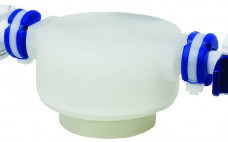Adoption of single-use manufacturing continues to expand globally and is showing no signs of slowing down. And why should it? The biopharmaceutical industry is challenged to produce safe, effective therapies and vaccines amid the constant pressure to lower cost per dose in addressing healthcare needs of not only the western hemisphere, but emerging markets as well. To meet these challenges, manufacturers are turning to single-use and hybrid systems that incorporate a balance of stainless and single-use equipment. Over the past…
Author Archives: John Boehm
Next-Generation Bioprocessing for Meeting Healthcare Challenges: The Role Single-Use Handling Systems Can Play
The rapid spread of contagious and lethal diseases worldwide has driven bioprocess suppliers to develop technologies for use in producing disease treatments and vaccines. Bioprocessors need to develop new biologics as well as rapid and reliable methods for bringing those treatments to commercialization. Implementing modular process solutions and single‑use handling systems in closed‑manufacturing processing is one approach to addressing those needs. Developing and discovering solutions for meeting global healthcare conditions is an evolving part of bioindustry. As points of reference,…
Genderless Sterile Connectors: How They Increase Flexibility, Reduce Complexity, and Drive Toward Standardization
Historically, single-use connections involved a male and a female half. These were two distinctly different parts that mated with each other. Genderless connections — those in which the connector halves are identical in design — bring multiple benefits to modular single-use systems. Read the full text of this application note in the PDF (Login required).
Modular System Design Supports Lean Manufacturing: The Role of Sterile Connectors in Modular Systems
No longer is the biopharmaceutical industry questioning whether it should use single-use technology. The focus has transitioned to how to best implement single-use systems. Rapid adoption of single-use systems has brought added complexity; which is leading to an increasing application of lean manufacturing principles. Standardization projects and establishing appropriate standards are current trends that drive toward reducing the complexity of bioprocessing systems, from design and validation to supply chain and manufacturing integration. Although efforts are underway to develop consensus standards…
Single-Use in the Final Fill Operation
Over the past decade the adoption of single-use technologies has moved beyond upstream processes to bulk and filling applications. One example of integrating single-use systems in a final fill operation is to simplify connections to mobile stainless steel transfer tanks. These tanks are designed to transfer product from formulation suites to storage areas and ultimately to filling suites. To allow sterile connection to and from these vessels, designers traditionally add three-way valve assemblies to fill…
Road Map to Implementation of Single-Use Systems
The Bio-Process Systems Alliance (BPSA) is an organization of equipment suppliers, service providers, and users in the biopharmaceutical industry whose shared mission is to facilitate implementation of single-use technologies in biomanufacturing processes. A key focus of BPSA’s core activities is to educate users and develop guides that help safeguard the quality of drugs and therapies produced with single-use process technologies. As an extension of its technical guides and white papers, BPSA realized the importance of developing…
Single-Use Connections Enable Advancements in Aseptic Processing
Today’s market demand for new drugs — combined with the difficult economic environment — is challenging bioprocessors to review their manufacturing systems and seek ways to make them more flexible, reliable, and cost effective. Increasingly, biomanufacturers are turning to single-use aseptic processing systems to meet or beat aggressive product-introduction timeframes while controlling costs. Innovative new single-use technologies continue to be introduced, giving pharmaceutical companies greater flexibility for replacing traditional stainless tubing, equipment, and even entire process suites with…
The Next Step in Implementing Disposables
Biopharmaceutical manufacturers face increased pressure to commercialize new drugs faster and at a lower cost. As a result, production demand is outpacing available manufacturing capacity. To meet existing and future demand and maintain a competitive advantage, many manufacturers are striving to develop increased efficiencies within their manufacturing processes. This is where single-use systems — particularly single-use transfer lines — can deliver significant value, including added flexibility, improved production yields, and increased cost savings. The trend today is toward transfer lines…

